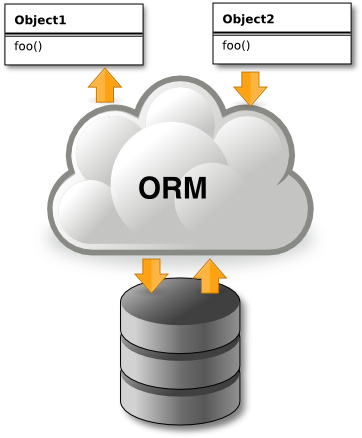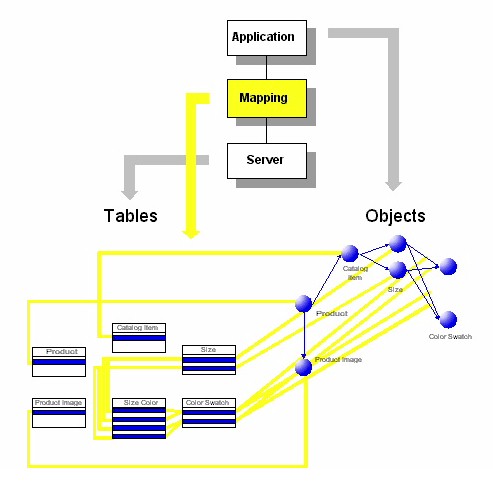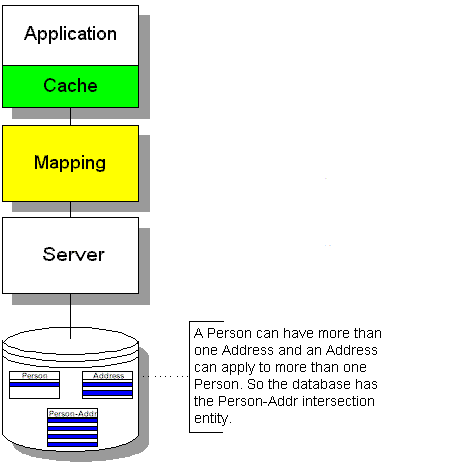CSC/ECE 517 Fall 2014/ch1a 25 jf: Difference between revisions
| Line 1: | Line 1: | ||
==Object-relational Mapping== | ==Object-relational Mapping== | ||
[http://en.wikipedia.org/wiki/Object-relational_mapping Object-relational Mapping] (ORM, O/RM, and O/R mapping) is a programming framework that allows you to define a mapping between application object model and the relational database. In an [http://en.wikipedia.org/wiki/Object_model Object model], the application objects are not aware of the database structure. Objects have properties and references to other objects. [ | [http://en.wikipedia.org/wiki/Object-relational_mapping Object-relational Mapping] (ORM, O/RM, and O/R mapping) is a programming framework that allows you to define a mapping between application object model and the relational database. In an [http://en.wikipedia.org/wiki/Object_model Object model], the application objects are not aware of the database structure. Objects have properties and references to other objects. [http://en.wikipedia.org/wiki/Database Databases] consist of tables with columns that maybe related to other tables. | ||
ORM provides a bridge between the relational database<ref>http://en.wikipedia.org/wiki/Relational_database Relational database</ref> and the object model and lead to a huge reduction in lines of code as ORM tools translate the query language into the appropriate syntax for the database for developers. By using ORM, you can access and update data entirely using the object model of an application. There are lots of free and commercial packages available that perform object-relational mapping. Object code<ref>http://en.wikipedia.org/wiki/Object_code Object code</ref> can be written using [http://en.wikipedia.org/wiki/Object-oriented_programming object-oriented programming (OOP)] languages such as [http://en.wikipedia.org/wiki/Java_(programming_language) Java], [http://en.wikipedia.org/wiki/Ruby_(programming_language) Ruby], [http://en.wikipedia.org/wiki/C%2B%2B C++] or [http://en.wikipedia.org/wiki/C_Sharp_(programming_language) C#]. | ORM provides a bridge between the relational database<ref>http://en.wikipedia.org/wiki/Relational_database Relational database</ref> and the object model and lead to a huge reduction in lines of code as ORM tools translate the query language into the appropriate syntax for the database for developers. By using ORM, you can access and update data entirely using the object model of an application. There are lots of free and commercial packages available that perform object-relational mapping. Object code<ref>http://en.wikipedia.org/wiki/Object_code Object code</ref> can be written using [http://en.wikipedia.org/wiki/Object-oriented_programming object-oriented programming (OOP)] languages such as [http://en.wikipedia.org/wiki/Java_(programming_language) Java], [http://en.wikipedia.org/wiki/Ruby_(programming_language) Ruby], [http://en.wikipedia.org/wiki/C%2B%2B C++] or [http://en.wikipedia.org/wiki/C_Sharp_(programming_language) C#]. | ||
Revision as of 01:15, 26 September 2014
Object-relational Mapping
Object-relational Mapping (ORM, O/RM, and O/R mapping) is a programming framework that allows you to define a mapping between application object model and the relational database. In an Object model, the application objects are not aware of the database structure. Objects have properties and references to other objects. Databases consist of tables with columns that maybe related to other tables.
ORM provides a bridge between the relational database<ref>http://en.wikipedia.org/wiki/Relational_database Relational database</ref> and the object model and lead to a huge reduction in lines of code as ORM tools translate the query language into the appropriate syntax for the database for developers. By using ORM, you can access and update data entirely using the object model of an application. There are lots of free and commercial packages available that perform object-relational mapping. Object code<ref>http://en.wikipedia.org/wiki/Object_code Object code</ref> can be written using object-oriented programming (OOP) languages such as Java, Ruby, C++ or C#.
Background
When we develop an object-oriented (OO) systems<ref>http://en.wikipedia.org/wiki/Object-oriented_analysis_and_design Object-oriented analysis and design</ref>, there's always a mismatch between the object model and the relational database. Database management system (DMS)<ref>http://www.eecs.berkeley.edu/Research/Areas/DBMS/ Database Management Systems (DBMS)</ref> represent data in a tabular format whereas object-oriented languages, such as Java, Ruby or C# represent it as an interconnected graph of objects.
In practice, we usually face lots of mismatch problems while working on an OO system. For example:
- Modifing the design of our database after having developed few pages or our application;
- Loading and storing objects in a relational database exposes us to the some mismatch problems;
- Having an object model which has more classes than the number of corresponding tables in the database;
- DMS doesn't define anything similar to Inheritance which is a natural paradigm in object-oriented programming languages and etc.
By using ORM, the mismatch properties and relationships of the objects in an application can be easily stored and retrieved from a database without writing SQL statements<ref>http://search.cpan.org/~rehsack/SQL-Statement-1.405/lib/SQL/Statement.pm SQL::Statement</ref> directly and with less overall database access code.<ref>Active Record Basics</ref>
ORM Architecture and Framework
Why to use ORM framework?
ORM framework are often used to reduce the amount of work, when developing an object-oriented system that stores data in a relational database. It is always a very slow and repetitive process to develop all the codes that is required to transfer the information between the object space and the relational space, but with the help of ORM framework, this trivial process can become much easier. The below picture is ORM framework.<ref name=Frameworks>An introduction to ColdFusion frameworks</ref>

What does ORM framework want to accomplish?
The goal of a ORM framework is to automatically map objects to and from a database seamlessly so that information can be quickly and easily retrieved in the object format, and then subsequently stored in its relational structure. This can make things easier in the process of system development and maintenance. The details of writing your own create, read, update, and delete methods are automatically generated for you, so you can concentrate on designing and building for your application.
In most cases, writing SQL and matching the data make developing your application really slow, and maintaining still needs to do numerous changes just for something simple, such as adding a column to a table. If using an ORM framework<ref>http://www.orm-designer.com/orm-frameworks ORM-frameworks</ref>, things will be far easier. It doesn't need to write the SQL statement to do create, read, update, and delete operations anymore — because it is automatically generated for you. Pulling information from the database is as simple as sending parameters to the framework. To update the data, it just needs to pass parameters back to the framework, which will manages it. Therefore, it can save lots of time to work on how the application is meant to function and how to design it, rather than the mundane details of pushing and pulling data from your database.
The below figure illustrates what occurs via using ORM framework in a project.<ref>Service Architecture-Mapping Layer</ref>

What does an ORM framework do?
ORM framework generates objects that virtually map the tables in a database. As a programmer, you would use these objects to interact with the database. So the main idea, is to try and shield the programmer from having to write optimized SQL code – the ORM generated objects take care of that for you. So let’s take a look at a simple example:
Say for instance you had a database with two tables:
- Clients
- Products
With a little bit of configuration on your part, the ORM framework would create corresponding objects (say, clients_object and products_object) that would handle all the database interaction. So let’s say you need to add a new client to the database, you would just have to use the ORM’s clients_object to add the new client. For example, it could be as simple as calling the object’s ‘save()’ method:
client = new clients_object("Stefan","Mischook");
client.save();
The above of code, is just pseudo code, mainly because the syntax will vary from ORM framework and from language to language.
How does ORM framework work?
In most of ORM tools, the ability to directly manipulate data stored in a relational database using an object programming language is called transparent persistence. It is different from a database sub-language used by embedded SQL or a call interface used by ODBC or JDBC. See transparent persistence vs. JDBC call-level interface.
By using an ORM tool, it means the framework will generate lots of code for you depending on how you use your data. You will have higher performance over an embedded SQL or a call interface. See caching for object-relational mapping.
With transparent persistence, the manipulation and traversal of persistent objects is performed directly by the object programming language in the same manner as in-memory, non-persistent objects. This is achieved through the use of intelligent caching as this animation shows<ref>How does ORM work under the covers?</ref>. For coding examples, see how to access data in a relational database.

When to use an ORM framework?
From most of programmers' experience, an ORM framework becomes more useful as the size and complexity of the project increases.Setting up an ORM framework may be unnecessary if you only have a simple database with 5 tables and 5-6 queries. In that case,when you have the following situations, the ORM framework will probably save you lots of time:
- 3 or more programmers on a web application.
- database consist of 10+ tables.
- 10+ queries to make.
Comparison between ORM and Traditional Methods
Compared to traditional techniques of exchange between an object-oriented language and a relational database, ORM often reduces the amount of code that needs to be written. However, when it comes to the Enterprise Application Development, maybe ORM will lead to other problems.
Simple Example with ORM
The Traditional Methods should first deal with a sql command and then set up a database connection. With the correct configuration of the database such as port, username and password, we will get the result of the database command and after that we can get what we want, the Object.<ref name=sample>StackOverFlow,What is an Object-Relational Mapping Framework?</ref>
// Traditional Method String sql = "SELECT ... FROM jobs WHERE id = 7" DbCommand cmd = new DbCommand(connection, sql); Result res = cmd.Execute(); Integer title = res[0]["TITLE"];
The Object Relational Mapping tools have configured the database for us. As developers, what we need to do is to get the Object. Therefore, what we need to do is to deal with the Object, in this case 'Job'.
//Using ORM Mapping Job p = repository.GetJob(7); Integer title = p.Title;
The code for different languages are similar, some frameworks also put a lot of the code in as static methods on the classes themselves, which means we could implement the process of getting Object even simpler.
Job p = Job.Get(7);
For some languages which implement complex query systems, we may use the following:
Job p = Job.Get(Job.Properties.Id == 7);
See Detailed Sample in Java concerning Objected Relational Mapping at A standardized object-relational mapping mechanism for the Java platform
ORM Advantage and Disadvantage
Advantage
- ORM provides a way to facilitate implementing the Domain Model pattern<ref>http://en.wikipedia.org/wiki/Domain_model Domain model</ref>, which means that developers can model entities based on real business concepts rather than based on database structure. ORM tools are strong of query capability and will translate the query language into the appropriate syntax for the database. This leads to huge reduction in lines of code and the ORM tools allows developers to focus on the business logic of the application rather than repetitive CRUD (Create Read Update Delete) logic.
- By using ORM tools, developers don't need to modify through different layers of the application if they want to make changes on SQL Update, Delete and Insert statements.The ORM will automatically use the updated structure for retrievals and updates once the object definitions have been updated<ref name=framework>What are ORM Frameworks?</ref>.
- ORM allows developers to navigate object relationships transparently with related objects automatically loaded as needed. Also the configurable data loading will help to load the appropriate data for each scenario.
- Equipped with concurrency support, ORM allows multiple users to update the same data simultaneously. Also ORM has transaction management and isolation patterns,which will scope the object changes to a transaction so that the entire transaction can either be committed or rolled back. Multiple transactions can be active in memory in the same time as well, keeping each transactions changes isolated form on another.
- Due to the cache management in ORM, entities are cached in memory thereby reducing load on the database.
- ORM's key management characteristics will propagate and manage identifiers and surrogate keys for developers when regarding to the database operations. <ref>MSDN,Ten advantages of an ORM (Object Relational Mapper)</ref>
Disadvantage
ORM seems have so many advantage regarding to small and personal web design and development, however, when it comes to large enterprise systems in Enterprise Application Development, it may lead to some problems because of its characteristics.<ref name=disadvantage>StackOverFlow,Disadvantage for ORM in Enterprise Application Development</ref>
- ORM technologies require configuration files to map table schemas into object structures,however, such configurations in large enterprise systems grow very quickly and become extremely difficult to create and manage. Maintaining the configuration also gets tedious and unmaintainable as business requirements and models constantly change and evolve in an agile environment.
- ORM framework is weak in dealing with customized query, which is also used in large enterprises. Mapping custom queries that do not fit into any defined object nor supported or recommended by the framework providers. In order to solve this problem, developers have to find work-arounds by writing ad hoc objects and queries, or writing custom code to get the data they need.
- Some of the ORM tools require proprietary binding(proprietary libraries and proprietary object query languages) that may not be standardized in the computer science industry. If the provider offers little or no flexibility to change, the developer won't be able to make a change to the specific modification unless to collaborate with the providers which will cost more time.
- The Object Query Languages provided by ORM seem like a benefit to Object Oriented developers by saving their time writing SQL. However, it will probably become a problem to developers in real industry since these query languages may not support some of the intermediate to advanced SQL constructs when Object Query Languages perform queries on the object model.<ref>http://www.combodo.com/IMG/pdf/OQL_Reference.pdf Object Query Language Reference</ref>
- ORM layers are using costly operations to instantiate and populate the objects with data from the database. Because of the little flexibility in the ORM framework, performance tuning the SQL is almost impossible. Therefore, the untuned and unoptimized queries produced by Object Query will cause significant performance losses and overloading of the database management systems.
- Caches in ORM provide a way to relieve the load on database by reducing the roundtrips but in the meantime it lead to synchronized problems. If not maintained and synchronized in a multi-tiered implementation, significant ramifications in terms of data-accuracy and concurrency will appear. To solve this problem,third party caches or external caches have to be plugged in,pressing more burden on the data-access layer.
ORM Language and Main Tools
This table just includes several well-known object-relational mapping tools regarding to some popular programming languages. It is not up-to-date or all-inclusive. <ref name=listOfORM>Wikipedia,List of Object-relational mapping Software</ref>
| Name | C++ | .NET | Objective-C | Java | Python | Perl | PHP | Ruby |
|---|---|---|---|---|---|---|---|---|
| Several Object-Relational Mapping Tools | LiteSQL | ADO.NET Entity Framework | core Data | jOOQ | Django | DBIx::Class | CakePHP | ActiveRecord |
| ODB | Nhibernate | Enterprise Objects | Apache_Gora | Peewee ORM | Doctrine | Sequel
| ||
| Wt::Dbo | OpenAccess ORM | Hibernate ORM | SQLAlchemy | FuelPHP | DataMapper |
Comparison between ORM tools
The following table lists several well-known object-relational mapping tools. The table clarifies the ORM tools by their platform, availability and current versions. The listed ORM tools almost covered most of the popular Object Oriented languages. <ref name=comparisonOfORM> Wikipedia, Comparison of Object-relational mapping Software</ref>
| ORM Tools | Platform | Availablity | Version |
|---|---|---|---|
| LiteSQL | C++ | Open Source | 0.3.15 / August 10, 2012 |
| ODB | C++ | Dual-licensed(GNU GPL/Proprietary License) | 2.3.0 / October 30, 2013 |
| Wt::Dbo | C++ | Dual-licensed(GNU GPL/Proprietary License) | 3.3.3 / May 27, 2014 |
| ADO.NET Entity Framework | .NET3.5(SP1)+ | Part of .NET 4.0 | EF5.0 |
| Nhibernate | .NET2.0(SP1)+ | Open Source | NH3.3.1 |
| OpenAccess ORM | .NET2.0+ | Free & Commercial | Version 2012.2.816.1 |
| core Data | Objective-C | Commercial | 3.2.0 |
| Enterprise Objects Framework | Objective-C | Commercial | WebObjects 5, released in 2001 |
| jOOQ | Java Virtual Machine | Dual-licensed(ASL 2.0/Commercial) | 3.3.0 / February 14, 2014 |
| Apache_Gora | Java Virtual Machine | Open Source | 0.4 / April 14, 2014 |
| Hibernate ORM | Java Virtual Machine | Open Source | 4.2.5 / August 28, 2013 |
| Django | Python | Open Source | 1.7 / September 2, 2014 |
| Peewee ORM | Python | Open Source | 2.2.3 / April 20, 2014 |
| SQLAlchemy | Python | Open Source | 0.9.4 / March 28, 2014 |
| DBIx::Class | Perl | Open Source | 0.08270 / January 31, 2014 |
| CakePHP | PHP | Open Source | 2.5.4 /September 2, 2014 |
| Doctrine | PHP | Open Source | 2.4/April 8, 2014 |
| FuelPHP | PHP | Open Source | 1.7.2/ July 13, 2014 |
| ActiveRecord | Ruby | Open Source | 4.2.0.beta1/ Aug 20, 2014 |
| Sequel | Ruby | Open Source | 4.14.0 / September 1, 2014 |
| DataMapper | Ruby | Open Source | 1.2.0/October 13, 2011 |
See Also
- Wikipedia, Object-relational Mapping
- Wikipedia, Object-oriented Programming
- Wikipedia, Object Query Language
- Hibernate Overview,What is Object/Relational Mapping?
- Object-relational Mapping Overview
- Service Architecture, Object-Relational Mapping Articles
- Object-Relational Mapping Concepts
- Choosing an object-relational mapping tool by Fabrice Marguerie
- Mapping Objects to Relational Databases: O/R Mapping In Detail
- RailsGuides Active Record Basics
- Ruby on Rails official website
- Object-Relational Mapping
References
<references></references>